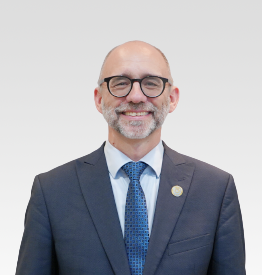My name is Dr. Joseph Murray, and I am President of the World Federation of the Deaf (WFD). Our organisation works tirelessly to secure the human rights of over 70 million deaf people worldwide, with its membership spanning 136 countries.
Deaf communities are linguistic minorities who also work within the disability movement. Deaf people have, over centuries, created communities around their national sign languages and the social connections built on the shared experience of being a sensory minority in an auditory world. National sign languages and deaf culture strengthens multilingualism and are means of promoting, protecting and preserving the diversity of languages and cultures globally. Deaf people are found among all cultural, linguistic, and ethnic minorities. Let me repeat this: deaf people are found in every country, every ethnic group, every language community and every minority. Deaf people worldwide consist of diverse and intersectional people everywhere on earth.
Nonetheless, we still struggle today to achieve full recognition for deaf people’s linguistic rights. Each country has its own national sign language(s), which are recognised by UNCRPD Article 2, that considers sign languages as equal as spoken languages. The WFD is working to support State Parties in the legal recognition of their national sign languages. By legally recognising and promoting national sign languages, deaf communities can participate completely in social, political, and economic life. Currently, only 77 out of the 193 State Parties to the UN have legally recognised their National Sign Languages. This means around 60% of Member States do not recognize the linguistic human rights of deaf people. We can and must achieve more!
Education is a fundamental right for all children, including deaf children. Nonetheless, many deaf students face barriers to accessing quality education and completing their entire education cycle. We must ensure that educational systems are fully accessible to deaf children in their natural languages- the over 200+ national sign languages found in every country in the world. This means deaf children should be educated in signing environments with signing peers, with teachers that are fluent in the national sign languages, and adult role models who are native speakers of their national sign languages. This multilingual environment has proven to be best practice, allowing them to acquire their national sign language and the national written language naturally.
And let’s work together to recognize and raise the status of national sign languages. Everyone, not only deaf people, should be proud that their country has its own indigenous signed language. And everyone should be able to learn and use their national sign languages, just as they use their national spoken languages. The WFD has a vision of a world where everyone is knowledgeable about and uses their national sign language as part of their community’s multilingual repertoires. Our vision is of a world where deaf people everywhere can sign anywhere. Join us in making this vision a reality.
Thank you.
2-minute statement:
Thank you Mr Chair,
Distinguished delegates,
My name is Dr. Joseph Murray, and I am President of the World Federation of the Deaf (WFD). Our organisation works tirelessly to secure the human rights of over 70 million deaf people worldwide, with its membership spanning 136 countries.
Deaf communities are linguistic minorities who also work within the disability movement. Deaf people have, over centuries, created communities around their national sign languages and the social connections built on the shared experience of being a sensory minority in an auditory world. National sign languages and deaf culture strengthens multilingualism and are means of promoting, protecting and preserving the diversity of languages and cultures globally. Deaf people are found among all cultural, linguistic, and ethnic minorities. Let me repeat this: deaf people are found in every country, every ethnic group, every language community and every minority. Deaf people worldwide consist of diverse and intersectional people everywhere on earth.
Nonetheless, we still struggle today to achieve full recognition for deaf people’s linguistic rights. Each country has its own national sign language(s), which are recognised by UNCRPD Article 2, that considers sign languages as equal as spoken languages. The WFD is working to support State Parties in the legal recognition of their national sign languages. By legally recognising and promoting national sign languages, deaf communities can participate completely in social, political, and economic life. Currently, only 77 out of the 193 State Parties to the UN have legally recognised their National Sign Languages. This means around 60% of Member States do not recognize the linguistic human rights of deaf people. We can and must achieve more!
Education is a fundamental right for all children, including deaf children. Nonetheless, many deaf students face barriers to accessing quality education and completing their entire education cycle. We must ensure that educational systems are fully accessible to deaf children in their natural languages- the over 200+ national sign languages found in every country in the world. This means deaf children should be educated in signing environments with signing peers, with teachers that are fluent in the national sign languages, and adult role models who are native speakers of their national sign languages. This multilingual environment has proven to be best practice, allowing them to acquire their national sign language and the national written language naturally.
And let’s work together to recognize and raise the status of national sign languages. Everyone, not only deaf people, should be proud that their country has its own indigenous signed language. And everyone should be able to learn and use their national sign languages, just as they use their national spoken languages. The WFD has a vision of a world where everyone is knowledgeable about and uses their national sign language as part of their community’s multilingual repertoires. Our vision is of a world where deaf people everywhere can sign anywhere. Join us in making this vision a reality.
Thank you.
